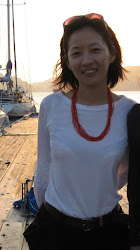Tarja.Questions
Tarja.Questions is table by Minako Okamoto [1].
The table specifies format of construction of questions in Tarja and in Japanese.
The table is important in construction of Tarja language.
Minako Okamoto
Minako Okamoto (shown in the picture) seems to have done great job in structuring of Japanese.
The table below represents the ascii version of general format of the Japanese questions.
The table below should occupy the whole with of your screen.
Hope, it is sufficiently wide.
Table
| question | some- | no- (with negative form of v. or adj.) | -ever | |
| What | nani // nan (used with desu ka) | nanika (something) | nanimo (nothing) | nandemo (whatever) |
| Where | doko | dokoka | dokonimo | dokodemo |
| When | itsu | itsuka | itsumo (always) | itsudemo |
| Who | dare | dareka | daremo | daredemo |
| Which (more than 2 choices) | dore | doreka (some of these) | doremo (none of these) | doredemo |
| Which (more than 2 choices; a noun follows dono) | dono+noun | dono + noun+ ka (some of these) | dono + noun + mo (none of these) | dono + noun + demo |
| Which (only 2 choices) | docchi | docchika (either of these) | docchimo (neither of these) | docchidemo |
| What kind of | donna + noun | - | - | - |
| Why | doshite / nande (more casual) | - | - | - |
| How 1 | do (used with desu ka) | - | - | - |
| How 2 | doyatte (used with a verb) | - | - | - |
| How much | ikura | - | - | - |
| How long | donogurai or donokurai | - | - | - |
| How old | nansai | - | - | - |
| How many people | nannin / nanmei (more formal) | nanninka / nanmeika | - | nannindemo / nanmeidemo (any number of people) |
| How many things | ikutsu | ikutsuka | - | Ikutsudemo (any number of things) |
| What time | nanji | - | - | nanjidemo |
Explanations
Here are explanations for the words marked in yellow.
docchi : meaning “which one” when you have two alternatives like meat or fish. It often refers to directions like this way or that way.
donogurai/donokurai:refers to time, distance or degree.
- Tokyo kara Osaka made donogurai (or nanjikan) kakarimasu ka? “How long (or how many hours) does it take to travel from Tokyo to Osaka?”
- Tokyo kara Osaka made donogurai (or nankilo) desu ka? “How long (or how many kilometers) is it from Tokyo to Osaka?”
- kono test wa donogurai muzukashii desu ka? “ How difficult will this test be?”
ikutsu :A general counter for objects, so you can use “ikutsu” for anything you want to know the number of. There are many other counter words for certain types of objects. Japanese people usually choose the appropriate counter word over “ikutsu” according to the object in question.
dokonimo : “Ni” is a particle which has two different meanings when it is used with “doko”. One indicates direction meaning “to” or “towards”. The other one indicates location meaning “in” or “at”.
ashita wa dokonimo ikanai. “I’m not going anywhere tomorrow.”
konoo machi wa conbini ga dokonimo nai. “There are no convenience stores anywhere in this city.” How is a series of these words used? Let’s take the nani-series as an example.
Q. nani o tabeteimasu ka? >> A. ramen o tabeteimasu. “Q. What are you eating? >> A. I’m eating ramen.”
Q. Asagohan o tabemashita ka? >> A, iie, kyo no asa nanimo tabemasendeshita. “Did you have breakfast? >> No, I didn’t eat anything this morning.”
Q. nani o tabemasho ka? >> A. nandemo ii desu yo. “What shall we eat? >> A. Anything is fine.”
Warning
The table is copied from the original with minimal TORIfication.
Minako Okamoto is copyright owned of the table above; please, communicate her for the commercial use.
References
- ↑ http://nihognodaybydayenglish.blogspot.com/search/label/Grammar Minako Okamoto. Nihongo Day By Day - English. 2021年8月16日月曜日.. 2019年10月19日土曜日 Question words
